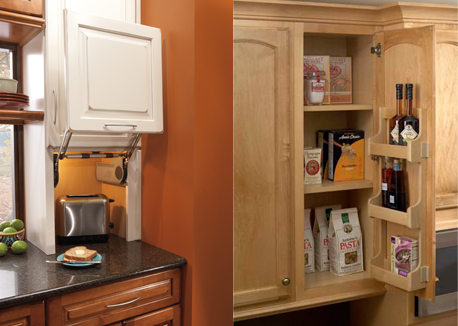Though there are plenty of differences in the interior design needs of our nation’s three most influential generational groups of homeowners—Baby Boomers, Generation X and Generation Y—a recent study done by cabinet and countertop manufacturer Masco Cabinetry, home of the KraftMaid, Merillat, QualityCabinets and DeNova brands, has found some common ground in the kitchen.
According to GenShift 2011: Lifestages Redefining the Kitchen, an industry study reporting generational and societal influences on kitchen design, all three generations are looking for more storage when it comes to kitchen cabinetry accessories. Homeowners in each generational group surveyed chose the same kitchen cabinetry extras as their three most important: a place for hiding small appliances, a place for bulk food and/or cleaning supplies and a place for waste and recycling.
In this article, we’ll take a closer look at each generational group and some of the factors that have likely led them toward similar kitchen cabinetry preferences. Design professionals who understand each generation and its design needs will be better prepared to deliver the kitchens homeowners want.
THREE GENERATIONS
• Baby Boomers. Born between 1946 and 1964, Baby Boomers represent the largest single population growth in U.S. history, accounting for approximately 76 million in our national population. 1 Many Baby Boomers have found themselves at a lifestage where they are in charge of their parents’ care, which has inspired them to make more informed choices in planning for their own senior years. Interestingly, more Baby Boomers are expressing a preference to age in place, rather than relocate after retirement. In fact, 63 percent of them plan to stay in their current home over the next five to 10 years.2 However, the GenShift 2011 study also discovered that 75 percent of Baby Boomers surveyed don’t feel their current kitchen layout is Universally Designed for their living needs. In short, these Boomers want more easily accessible kitchen design features without sacrificing aesthetics.
• Generation X. Of the three generations, Generation X, or Gen X, is in the middle in terms of age and smallest in population at 50 million.3 Born between 1967 and 1976, Gen X is busy raising children and advancing their careers while trying to find that ever-elusive balance of work and home life. This generation is always on the go and specific design elements can help complement a fast-paced lifestyle.
• Generation Y. The youngest of the three generations, born between 1977 and 1993, Generation Y, or Gen Y, is sometimes also collectively known as “Millennials” or “Echo Boomers.” They currently make up the largest portion of the American population at 84 million.4 Although they’re somewhat new to the workforce, they’re already in the market for big-ticket purchases, such as homes. Armed with the latest technologies, Gen Y looks to third parties or the Internet for advice, information and the lowest price for getting exactly what they want.
BRIDGING THE GAP
As the GenShift 2011 study demonstrates, the one kitchen design need that all three generations share is a love for multifunctional storage solutions and kitchen spaces that reflect their own individual style and can accommodate multiple generations living in the same home. Their need for this extra storage is often motivated by homeowners buying a larger variety of kitchen appliances. Storage options help minimize clutter on countertops as they help hide food processors, coffee grinders and other kitchen gadgets. Today’s homeowner wants the latest kitchen gadgets and it’s important for designers to provide convenient, easily accessible storage space for these addictive appliances.
Another factor that has come into play, coffee drinking has become more of an obsession, instead of a mere habit, for all three generations. Keeping all the coffee supplies in one place, possibly close to the sink, is a convenience today’s homeowners might appreciate.

Hidden storage space can take many forms. For example, appliance garages are being replaced by slide-out storage and countertop cabinets with doors that raise up and out of the way. In addition, strategically placed power outlets can help prevent cords from becoming a jumbled, tangled mess, and by providing innovative solutions under sinks, designers can make storage and cleanup more convenient than ever.

Then there’s the issue of waste disposal. With the growing interest in recycling and “going green” in recent years, all three generations of homeowners are looking for new ways to dispose of kitchen waste responsibly, while also keeping it out of sight. In the 1970s and ’80s, many custom kitchens had trash compactors for this purpose. Today, however, slide-out trash and recycling bins are making kitchens even more functional. It’s important for designers to consider the most efficient placement for such features—possibly under the main sink, a bar or prep sink—and which way the cabinet doors open in relation to one another.
Multigenerational homeowners are also beginning to request different pantry configurations. While traditional pantries are still common, more homeowners are now opting for tall, slide-out cabinet storage. Tall, adjustable shelves can accommodate big cereal boxes, heavy canned goods and even large appliances, such as slow cookers. Often, these slide-out cabinets are positioned near the entrance to the garage, which helps make unloading groceries more convenient.
These are only a few of the creative storage ideas designers can use to serve the kitchen needs of today’s homeowners and make their lives easier in the process.
UNIVERSAL APPEAL
In today’s world, a difference in age doesn’t always mean a difference in interior design preferences. However, each generation has its own unique needs when it comes to the kitchen as a whole. Today’s kitchen designs should be specific enough to reflect the personal preferences and needs of today’s homeowners, yet flexible enough to accommodate a rapidly changing household demographic. Considering the number of households that include a variety of generations—such as adult children, aging parents, multigenerational marriages, children and grandchildren—Universal Design is crucial for serving today’s universal homeowners.
As design professionals continue to grow in their understanding of each generation’s needs—and the needs of all generations collectively—they will produce more efficient, accessible kitchens that are a hit with homeowners of all ages.
—Sarah Reep is director of Designer Relations and Education at
Masco Cabinetry.
1. Approaching 65: A Survey of Baby Boomers Turning 65 Years Old, AARP
2. Masco Cabinetry GenShift 2011 Study
3. Masco Cabinetry GenShift 2011 Study
4. Masco Cabinetry GenShift 2011 Study









